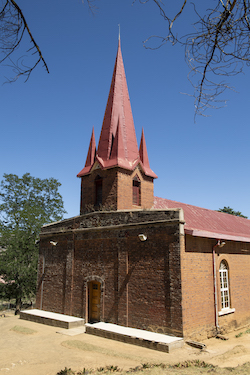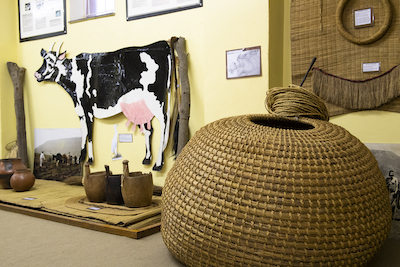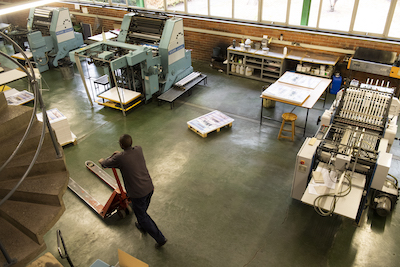
You are here: Explore > Places to Visit > Morija and Matsieng
Historic Morija, one of Lesotho’s oldest and prettiest towns, is nestled on well-wooded slopes overlooked by the spectacular sandstone escarpment of Mount Makhoarane, 45km south of Maseru.
 Named after the Biblical Mount Moriah, Morija houses Lesotho’s first and oldest French Protestant mission, established in 1833 by Thomas Arbousset, Eugene Casalis and Constant Gosselin of the Paris Evangelical Mission Society (PEMS). The mission incorporates the kingdom’s two oldest standing buildings, both of which survived a destructive fire set during the First Basotho-Boer War of 1858. These are the modest stone-and-thatch house constructed by the Swiss missionary François Maeder in 1843, and the more imposing tall-spired redbrick Lesotho Evangelical Church constructed by the PEMS over 1847-57.
Named after the Biblical Mount Moriah, Morija houses Lesotho’s first and oldest French Protestant mission, established in 1833 by Thomas Arbousset, Eugene Casalis and Constant Gosselin of the Paris Evangelical Mission Society (PEMS). The mission incorporates the kingdom’s two oldest standing buildings, both of which survived a destructive fire set during the First Basotho-Boer War of 1858. These are the modest stone-and-thatch house constructed by the Swiss missionary François Maeder in 1843, and the more imposing tall-spired redbrick Lesotho Evangelical Church constructed by the PEMS over 1847-57.
 In the early colonial era, Morija was nicknamed Selibeng sa Thuto (Well-Spring of Learning), due to the important role it played in providing education to the Sotho elite. The town’s scholastic reputation was cemented in 1956, when the Morija Museum and Archives (MMA) was established to store and display various ethnographic, geological and fossil collections made by missionaries in the 19th century. Now housed in a conspicuous yellow building, the MMA also incorporates Lesotho’s most important historical archive, containing a wealth of documents and other material dating back to the 1860s, along with a book shop and a small terrace café.
In the early colonial era, Morija was nicknamed Selibeng sa Thuto (Well-Spring of Learning), due to the important role it played in providing education to the Sotho elite. The town’s scholastic reputation was cemented in 1956, when the Morija Museum and Archives (MMA) was established to store and display various ethnographic, geological and fossil collections made by missionaries in the 19th century. Now housed in a conspicuous yellow building, the MMA also incorporates Lesotho’s most important historical archive, containing a wealth of documents and other material dating back to the 1860s, along with a book shop and a small terrace café.
 Other important landmarks include a sandstone post office built in 1884 and the Morija Printing Press, which has occupied several different premises since it published the first edition of the pioneering Leselinyana la Lesotho (“Little Light of Lesotho”) newspaper back in 1863. Altogether more contemporary in feel, Morija Arts Centre is a rootsy cooperative whose members display their paintings, pottery, tapestries and other artworks in a funky arts and craft shop set in the old François Maeder House.
Other important landmarks include a sandstone post office built in 1884 and the Morija Printing Press, which has occupied several different premises since it published the first edition of the pioneering Leselinyana la Lesotho (“Little Light of Lesotho”) newspaper back in 1863. Altogether more contemporary in feel, Morija Arts Centre is a rootsy cooperative whose members display their paintings, pottery, tapestries and other artworks in a funky arts and craft shop set in the old François Maeder House.
Matsieng, 7km to the east of Morija, has served as the home of the Sotho monarchy ever since Letsie I succeeded his father Moshoeshoe I as king in 1870. Now graced by a trio of modern country palaces built for Moshoeshoe II and Letsie III, Matsieng is also home to the Royal Archives, Museum and Information Resource Centre, which offers guided tours that include a short but bracing walk uphill to the ruins of the original stone palace built by Letsie I.
A popular walk short from Morija, usually taking around 30 minutes in either direction, leads to a fossil set of three-toed dinosaur footprints first discovered by missionaries in 1881. This intriguing site is known locally as Nonyana ea Makhoarane (Bird of Makhoarane) due to the footprints’ resemblance to giant avian tracks. The walk up the slopes of Mount Makhoarane can also be rewarding for living birds. Look out for bokmakierie, ground woodpecker and Cape rock thrush on the rocks, and various water-associated species on the small tree-fringed reservoir you pass en route.
Sleeping: Although Morija is easily visited as a day trip from Maseru, it is also serviced by the budget friendly Morija Guest House, which boats an attractive location on the slopes above the town.
Eating: Cafe Mojo, set in the gardens of the Morija Museum & Archives, is a great spot for a coffee or light lunch - wood-fired pizza is the specialty.
Access: Morija lies about 45km south of Maseru along the surfaced A2. Allow one hour in either direction for the drive. Plenty of public transport runs back and forth between the two.
Preparations: A visit will be greatly enhanced by buying the inexpensive and most informative Guide to Morija published and sold by the Morija Museum & Archives.


